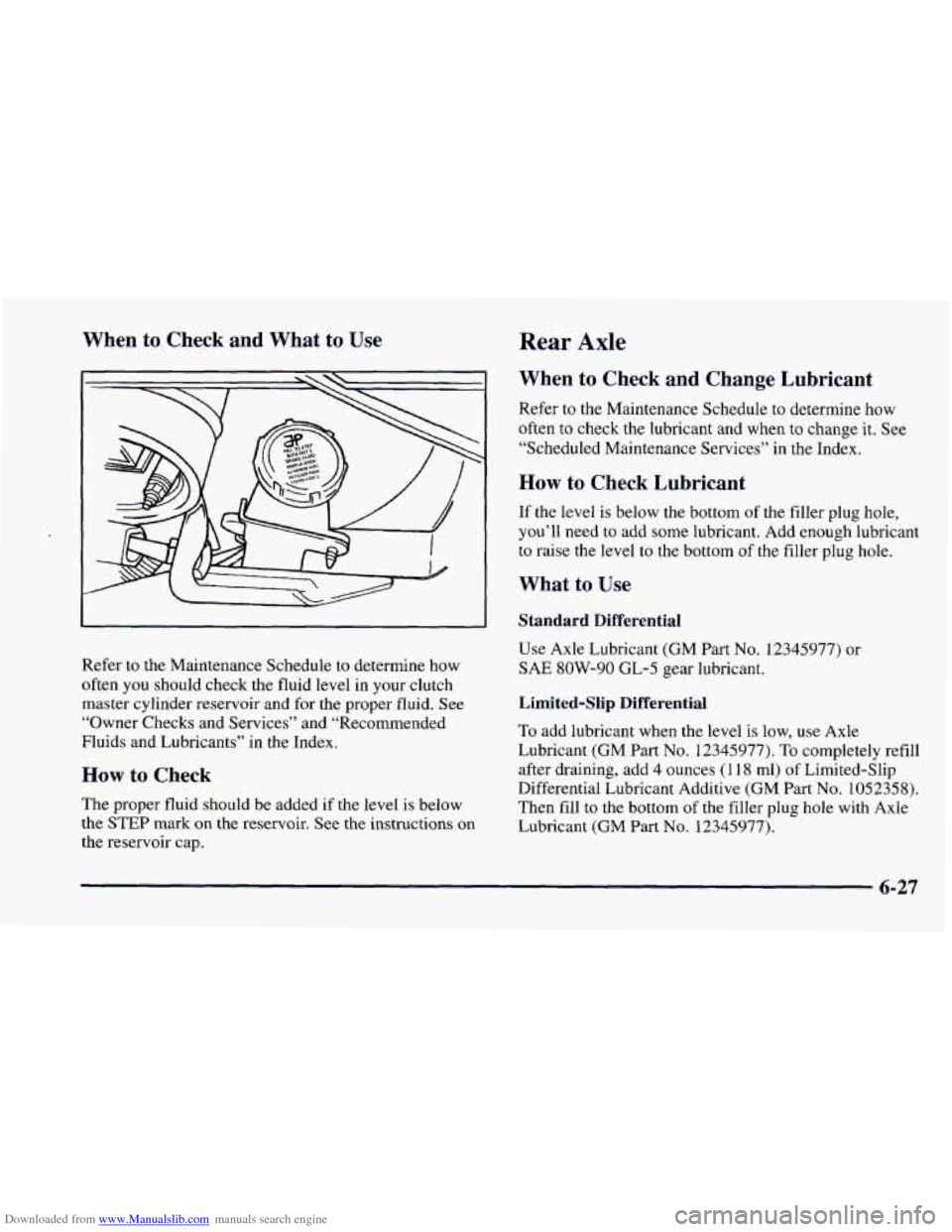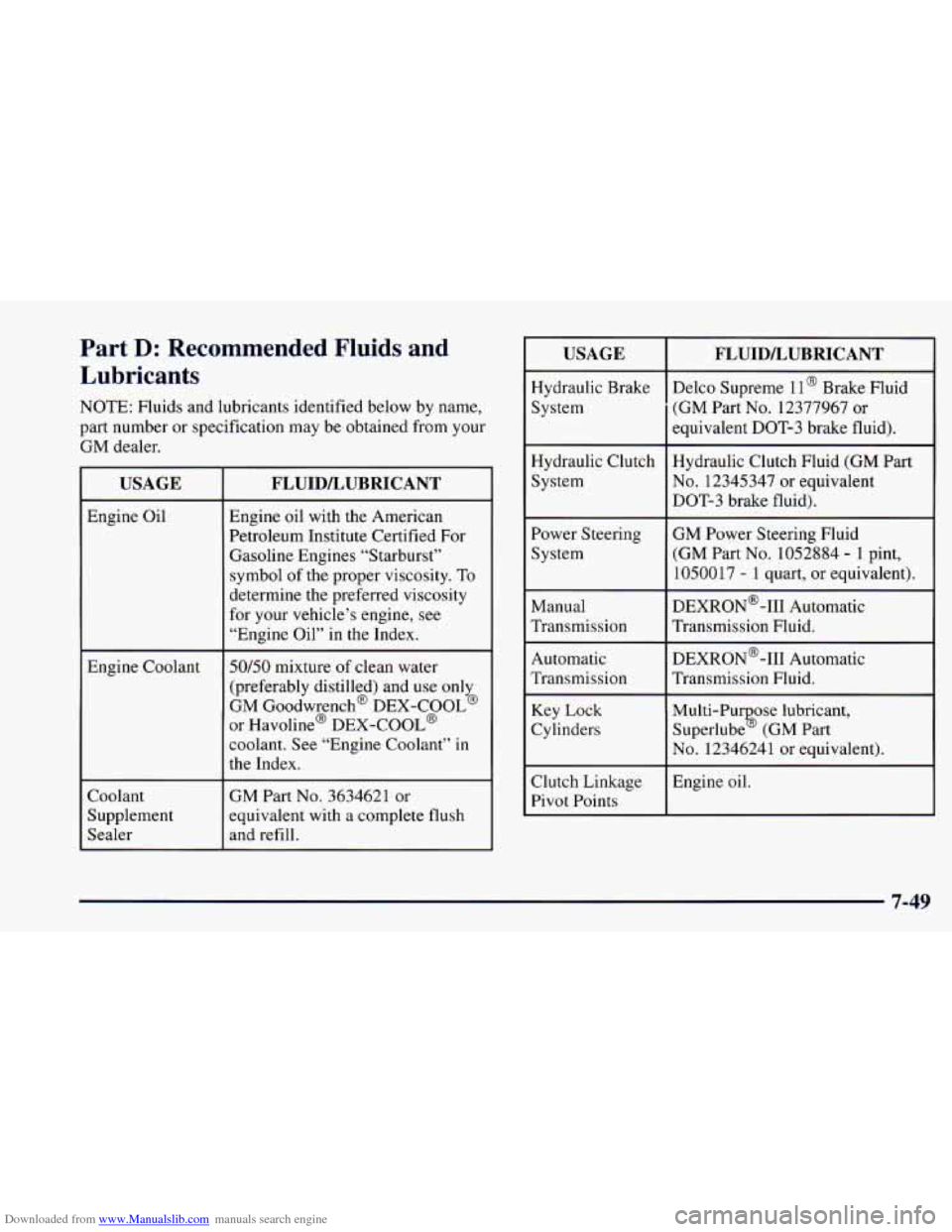Page 101 of 404

Downloaded from www.Manualslib.com manuals search engine Reducing Speed While Using Cruise Control
There are two ways to reduce your speed while using
cruise control:
0 Push in the button at the end of the lever until you
reach the lower speed you want, then release it.
To slow down in very small amounts, push the
button for less than half a second. Each time you do
this, you’ll go 1 mph
(1.6 kmh) slower.
Passing Another Vehicle While Using Cruise Control
Use the accelerator pedal to increase your speed. When
you take your foot off the pedal, your vehicle will slow
down to the cruise control speed you set earlier.
Using Cruise Control on Hills
How well your cruise control will work on hills depends
upon your speed, load and the steepness of the hills.
When going up steep hills,
you may have to step on the
accelerator pedal
to maintain your speed. When going downhill,
you may
have to brake or shift to a lower gear
to keep your speed down. Of course, applying the brake
takes you out of cruise control. Many drivers find this to
be
too much trouble and don’t use cruise control on
steep hills.
Ending Out of Cruise Control
There are several ways to turn off the cruise control:
0 Step lightly on the brake pedal or push the clutch
pedal,
if you have a manual transmission; OR
0 Move the cruise switch to OFF.
Erasing Speed Memory
When you turn off the cruise control or the ignition,
your cruise control set speed memory
is erased.
2-51
Page 256 of 404
Downloaded from www.Manualslib.com manuals search engine When you open the hood of the 3800 Engine you'll see:
.. > .. - k
A. Engine Coolant Reservoir
B. Battery
C. Oil Fill Cap
D. Automatic Transmission Dipstick
(If Equipped))
E. Engine Fan I. Brake Fluid Reservoir
F. Windshield Washer Reservoir J. Clutch Fluid Reservoir
G. Power Stee.ring Reservoir (If Equipped))
H. Engine Oil Dipstick K. Air Cleaner
6-10
Page 257 of 404
Downloaded from www.Manualslib.com manuals search engine When you open the hood of the 5.7L Engine you’ll see:
A. Engine Cool ant Res ervoir
B. Power Steering Reservoir
C. Engine
Oil Dipstick
D. Battery
E. Engine Oil Fill Cap
E Automatic Transmission
Dipstick
(If Equipped)
G. Fan
H. Windshield Washer Reservoir
I. Brake Fluid Reservoir
J. Clutch Fluid Reservoir
(If Equipped)
K. Air Cleaner
6-11
Page 272 of 404

Downloaded from www.Manualslib.com manuals search engine Check the fluid level only when your engine is off, the
vehicle is parked on a level place and the transmission is
cool enough for you
to rest your fingers on the
transmission
case.
Then, follow these steps:
1. Remove the filler plug.
2. Check that the lubricant level is up to the bottom of
the filler plug hole.
3. If the fluid level is good, install the plug and be sure
it is fully seated. If the fluid level is low, add more
fluid as described in the
next steps.
How to - ~ ~ Fluid A.
Here’s how to add fluid. Refer to the Maintenance
Schedule to determine what kind
of fluid to use. See
“Recommended Fluids and Lubricants” in the Index.
1. Remove the filler plug.
2. Add fluid at the filler plug hole. Add only enough
fluid to bring the fluid level up to the bottom of the
filler plug hole.
3. Install the filler plug. Be sure the plug is fully seated.
Hydraulic Clutch
The hydraulic clutch linkage in your vehicle is
self-adjusting. The clutch master cylinder reservoir is
filled with hydraulic clutch fluid.
It isn’t a good idea
to “top off’ your clutch fluid. Adding
fluid won’t correct a leak.
A fluid loss in this system could indicate
a problem.
Have
the system inspected and repaired.
6-26
Page 273 of 404

Downloaded from www.Manualslib.com manuals search engine When to Check and What to Use
Refer to the Maintenance Schedule to determine how
often you should check the fluid level in your clutch
master cylinder reservoir and for the proper fluid. See
“Owner Checks and Services” and “Recommended
Fluids and Lubricants’’ in the Index.
How to Check
The proper fluid should be added if the level is below
the
STEP mark on the reservoir. See the instructions on
the reservoir cap.
Rear Axle
When to Check and Change Lubricant
Refer to the Maintenance Schedule to determine how
often
to check the lubricant and when to change it. See
“Scheduled Maintenance Services” in the Index.
How to Check Lubricant
If the level is below the bottom of the filler plug hole,
you’ll need to add some lubricant. Add enough lubricant
to raise the level to the bottom of the filler plug hole.
What to Use
Standard Differential
Use Axle Lubricant (GM Part No. 12345977) or
SAE 8OW-90 GL-5 gear lubricant.
Limited-Slip Differential
To add lubricant when the level is low, use Axle
Lubricant (GM Part
No. 12345977). To completely refill
after draining, add 4 ounces (1 18 ml)
of Limited-Slip
Differential Lubricant Additive
(GM Part No. 1052358).
Then fill to the bottom
of the filler plug hole with Axle
Lubricant
(GM Part No. 12345977).
6-27
Page 368 of 404

Downloaded from www.Manualslib.com manuals search engine At Least Twice a Year
Restraint System Check
Make sure the safety belt reminder light and all your
belts, buckles, latch plates, retractors and anchorages are
working properly. Look for any other
loose or damaged
safety belt system parts.
If you see anything that might
keep a safety belt system from doing its job, have it
repaired. Have any torn or frayed safety belts replaced.
Also look for any opened or broken air bag covers, and
have them repaired or replaced. (The air bag system
does not
need regular maintenance.)
Wiper Blade Check
Inspect wiper blades for wear or cracking. Replace blade
inserts that appear worn or damaged or that streak or
miss areas
of the windshield. Also see “Wiper Blades,
Cleaning” in the Index.
Manual Transmission Check
Check the transmission fluid level; add if needed.
See “Manual Transmission’’ in the Index.
A fluid
loss may indicate a problem. Have the system inspected
and repaired
if needed.
Automatic Transmission Check
Check the transmission fluid level; add if needed. See
“Automatic Transmission” in the Index.
A fluid loss
may indicate
a problem. Check the system and repair
if needed.
Hydraulic Clutch System Check
Check the fluid level in the clutch reservoir. See
“Hydraulic Clutch Fluid” in the Index.
A fluid loss in
this system could indicate a problem. Have the system
inspected and repaired
at once.
At Least Once a Year
Key Lock Cylinders Service
Lubricate the key lock cylinders with the lubricant
specified in Part
D.
Body Lubrication Service
Lubricate all hinges and latches, including those for the
hood, rear compartment, console doors and any folding
seat hardware. Part
D tells you what to use. More
frequent lubrication may be required when exposed to a
corrosive environment.
7-44
Page 369 of 404

Downloaded from www.Manualslib.com manuals search engine Starter Switch Check
/d, CAUTION:
m I-
When you are doing this check, the vehicle could
move suddenly. If it does, you
or others could be
injured. Follow the steps below.
1. Before you start, be sure you have enough room
2. Firmly apply both the parking brake (see “Parking around the vehicle.
Brake” in the Index if necessary) and the regular brake.
NOTE:
Do not use the accelerator pedal, and be
ready to turn off the engine immediately if it starts.
3. On automatic transmission vehicles, try to start the
engine in each gear. The starter should work
only in
PARK
(P) or NEUTRAL (N). If the starter works in
any other position, your vehicle needs service.
On manual transmission vehicles, put the shift lever
in NEUTRAL (N), push the clutch down halfway
and try to start the engine. The starter should work
only when the clutch is pushed down all the way to
the floor. If the starter works when the clutch isn’t
pushed all the way down, your vehicle needs service.
Brake-Transmission Shift Interlock (BTSI) Check
(Automatic Transmission)
1 A CAUT’ON:
I-
-
When you are doing this check, the vehicle could
move suddenly. If it does, you
or others could be
injured. Follow the steps below.
1. Before you start, be sure you have enough room
around the vehicle. It should be parked on a
level surface.
2. Firmly apply the parking brake (see “Parking Brake’
in the Index if necessary).
NOTE: Be ready to apply the regular brake
immediately if the vehicle begins to
move.
3. With the engine off, turn the key to the RUN
position, but don’t start
the engine. Without applying
the regular brake, try
to move the shift lever out of
PARK (P) with normal effort. If the shift lever
moves out of PARK (P), your vehicle’s BTSI
needs service.
7-45
Page 373 of 404

Downloaded from www.Manualslib.com manuals search engine Part D: Recommended Fluids and
Lubricants
NOTE: Fluids and lubricants identified below by name,
part number or specification may be obtained from your
GM dealer.
USAGE
Engine Oil
Engine Coolant
Coolant
Supplement Sealer
FLUIDLUBRICANT
Engine oil with the American
Petroleum Institute Certified For
Gasoline Engines “Starburst”
symbol
of the proper viscosity. To
determine the preferred viscosity
for your vehicle’s engine,
see
“Engine Oil” in the Index.
50/50 mixture of clean water
(preferably distilled) and use only
GM Goodwrench@ DEX-COOL@
or Havoline@ DEX-COOL@
coolant. See “Engine Coolant” in
the Index.
GM Part No. 3634621 or
equivalent with a complete flush
and refill.
USAGE
Hydraulic Brake
System
Hydraulic Clutch
System
Power Steering
System
Manual
Transmission
Automatic
Transmission
Key Lock
Cylinders
Clutch Linkage
Pivot Points
FLUIDLUBRICANT
Delco Supreme 11 @ Brake Fluid
(GM Part No. 12377967 or
equivalent DOT-3 brake fluid).
Hydraulic Clutch Fluid (GM Part
No. 12345347 or equivalent
DOT-3 brake fluid).
GM Power Steering Fluid
(GM Part No. 1052884
- 1 pint,
1050017
- 1 quart, or equivalent).
DEXRONO-I11 Automatic
Transmission Fluid.
DEXRON@-I11 Automatic
Transmission Fluid.
Multi-Pur ose lubricant,
Superlube
% (GM Part
No. 12346241
or equivalent).
Engine oil.
7-49